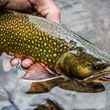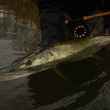For the next couple weeks, the Atlantic States Marine Fisheries Commission is soliciting public comment on Draft Amendment 7 to the Atlantic Striped Bass Management Plan. This is an amazing opportunity to improve several facets of management, leading to more striped bass in the water in the future. Today, striped bass are overfished, subject to overfishing (according to the most recent stock assessment), and at a 25-year low. It’s going to take all of us acting together if we want to improve striped bass management and restore the stock to abundant, healthy levels.
Before we look at Draft Amendment 7, I want folks to realize just how complex this document—and striped bass management, more broadly—is. Draft Amendment 7 involves four primary topics: management triggers, recreational release mortality, rebuilding plan, and conservation equivalency. And when I said complex, I meant it—this document has 18 decision points with more than 50 complex sub-options to choose from. In the following paragraph, I’ll share some overarching perspectives on these four issues and how to comment. But if you want the full state of play, that’s where the folks at the American Saltwater Guides Association come in. ASGA, for which I’m the Maine Board Member, is leading the charge for Draft Amendment 7 and striped bass conservation. Head on over to their action page for in-depth recommendations and fine-tuned instructions for how to effectively comment on this document.
How to Comment
Because comments are so important, I don’t want to bury this. Check out ASMFC’s public comment page for all the details on state hearings and how to send written comments. To submit a written comment, simply email comments@asmfc.org with Draft Amendment 7 in the subject line with your positions. It’s important to make these somewhat personalized, because ASMFC weights form letters less than individual comments. Also, be sure to CC stripercomments@gmail.com to be entered into an ASGA raffle with some awesome gear—your positions don’t matter, they’re just trying to get more people engaged and participating in this process!
Draft Amendment 7
Ok, let’s dive in. When it comes to striped bass and its management, understand that this is an incredibly diverse fishery. Up in the cool waters of Maine, where I fish and guide, we have a shorter window when the fish are here in strong numbers, and there’s also no commercial fishery here. Then take Maryland, for example, this state essentially has a 12-month long fishing season and consistently catches large percentages of coastwide recreational and commercial harvests. That perspective will be relevant for a couple of these issues.
Management Triggers
Let’s tackle the management triggers, which inform when and how the Striped Bass Board responds to new information about the stock. The intent of the triggers is to maintain sustainable levels of the stock. Broadly speaking, the management triggers work when they’re followed. So, let’s keep them strong and avoid delaying action. However, we could improve this section by requiring the Striped Bass Board to implement a rebuilding plan within two years of an overfished designation. Also, we need to tweak the recruitment trigger so that it actually trips when the coastal stock experiences poor recruitment. Tied to that option, the Board needs to be compelled to react to periods of low recruitment by reducing mortality—this trigger and response will act as a warning alarm for a decreasing population and help to proactively manage the stock.
Recreational Release Mortality
This next section, recreational release mortality, is difficult for me. Recreational anglers are responsible for the vast majority of total striped bass removals, and a significant portion of that is attributable to catch and release mortality (9 percent of all released fish are assumed to die). We as recreational anglers have a large impact, even if we swear off intentionally harvesting stripers. Thus, no matter what the outcome of this section is in May, all anglers should do everything they can to reduce their post release mortality. Check out this informational guide I helped with last year on best practices for safe release.
There are several option sets in this section, some of which I’m supportive of and others that bring concerns. I am supportive of disallowing gaffs for striped bass and increasing angler outreach and education. No brainer!
This document considers a range of closures to address the high levels of mortality in the recreational sector. Regarding potential seasonal no-targeting closures up and down the coast: I’m as conservation-oriented as they come, but how are you going to tell me to close down my business for two weeks during my short fishing season and not even know the conservation benefit it will have?
These no targeting closures will have serious impacts on the light tackle and fly fishing guide community in the Northeast, but private anglers will still catch stripers while ‘targeting’ bluefish or black sea bass. It’s also a tough pill to swallow when you think about what really drives post release mortality: warm water temperatures, poor handling, gut hooking, low salinity, and low dissolved oxygen. Those environmental issues are huge problems in places like the Chesapeake Bay in the summer or certain coastal rivers, but it’s not nearly the same problem in the ocean waters off New England.
Broadly speaking, we should not be killing fish before they spawn—that’s just commonsense fisheries management. However, the spawning closure options in this section (which could be either no-harvest or no-targeting) do not seem to have the necessary details nor protections. For example, should we include staging areas and/or shut down all harvest coastwide until fish have spawned? Just some thoughts that aren’t discussed in this document. Also, after talking with the ASGA team, they are anticipating an addendum after the stock assessment is released this fall; that seems like a good time to tackle this issue head on and develop more details, strategies, and goals for spawning protections.
So, to sum up this section—I’m pretty worried about these no targeting closures and want the Board to develop more robust options for protecting spawning fish.

Conservation Equivalency
Probably the single most important issue in Draft Amendment 7 is conservation equivalency. This management program is a way to provide states with flexibility in managing the diverse striped bass fishery. Unfortunately, it has been abused by several states fairly consistently, which has also contributed to the current condition of the stock. You see, conservation equivalency usually injects additional uncertainty into management, which can have serious impacts. States should still be allowed to use CE, but there should be strong guardrails to prevent abuses and ensure conservation goals are being met. So, in Draft Amendment 7, I’m supporting options that bring more accountability to this program, such as restricting the use of CE if the stock is overfished, requiring minimum state recreational data standards, and employing an uncertainty buffer (luxury tax).
Rebuilding Plan
Finally, Draft Amendment 7 considers a rebuilding plan to address the overfished designation for striped bass. We successfully addressed the overfishing designation last year with Addendum 6 and new regulations, but this is different. All things considered, the rebuilding plan issue is fairly simple. The Striped Bass Board has to rebuild the species by 2029, and this section provides the Board with options to do so under a low-recruitment assumption and to react more quickly this fall if the new stock assessment contains concerning information. I want to see striped bass rebuilt quickly and without any further delay. Both of these options will help achieve that.
Digesting all of this and developing personal comments is a pretty hefty lift—I get it. But that’s what it’s going to take to recover this iconic fish. We all need to get engaged, much like you’ve probably seen down in Florida over this budget bill with negative implications for the Everglades and clean water. Like my friend Captain Benny Blanco likes to say, “we’re all one community,” and we should help everyone’s fisheries when we can. If you have more questions about how to get involved or anything regarding Draft Amendment 7, be sure to reach out to the ASGA team on Instagram—they’ll get you going in the right direction!






























Comments